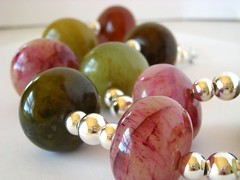
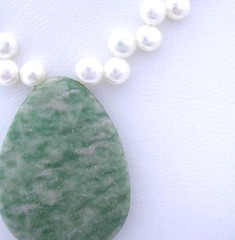
Colour: all colours, mostly green
Hardness: 6-7, depending on variety
Fracture: splintery, brittle
Crystal system: monoclinic – aggregrate
Chemical composition: sodium aluminum silicate
Transparency: opaque to transluscent
Refers to two distict minerals, namely jadeite and nephrite. Known as a gemstone for over 7000 years, the Chinese word for jade yu is not used. Rather the name comes from the term piedra de hijada, dating from time of the Spanish conquest of Central and South America when the stone was used as a protection against kidney diseases and hip complaints.
In prehistoric times it was found to be a tough and durable material (it is tougher than steel!) and was used for axes, weapons and tools. In China and pre-Columbian Central America, jade was carved into figures and symbols.
Jade is found in Burma, China, Japan, Canada, Guatemala, Kazakhstan, Russia, and the USA, New Zealand, Australia, Brazil, Zimbabwe, Taiwan, Alaska and Poland.
Much of the jade today is treated to improve colour and appearance.
There are a number of imitations and some stones, such as serpentine are called ‘jade’ – such as ‘new jade’ or ‘olive jade’. Jade can be confused with aventurine, amazonite, chrysoprase, garnet, prase, prehnite, serpentine, emerald.
Metaphysical practioners believe jade to be a symbol of purity and serenity that signifies wisdom gathered in tranquility; that it protects, brings good luck and friendship.
Jasper
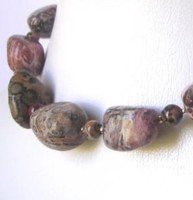
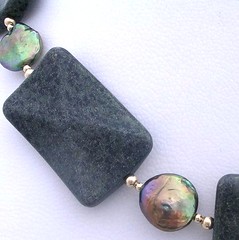
Colour: all colours
Hardness: 6.5-7
Cleavage: none
Fracture: splintery, conchoidal
Crystal system: cryptocrystalline
Chemical composition: silicon dioxide
Transparency: opaque
Jasper is a chalcedony or cryptocrystalline quartz, however some jaspers have a more grainy structure. The name means ‘spotted stone’ in Greek, however history reveals that the term jasper referred to a number of different stones including transparent green varieties!
Usually jasper is multicoloured, striped, flamed or spotted. It is not unusual for jaspers to contain 20% foreign materials. Sometimes it can be grown with agate or opal and includes fossilized material. The inclusion of these different materials, rocks and minerals means that many unusual patterns and pictures can be seen in the stones.
Found in Egypt, Australia, Brazil, India, Canada, Kazakhstan, Madagascar, Russia, Uruguay, USA. There are many different varieties with a sea of names describing them. Some of the more well known ones are: picture jasper, leopardskin jasper, poppy jasper, mookaite, imperial, brecciated, kambaba jasper…
Metaphysical practioners call jasper the ‘supreme nuturer’ as they believe it supports, brings balance and unifies. When used by crystal healers it is believed to support the circulatory and digestive organs and to balance the body’s mineral content.
Jet
Colour: black, dark brown
Hardness: 2.5-4
Cleavage: none
Fracture: conchoidal
Crystal system: organic
Chemical composition: lignite
Transparency: opaque
The name jet comes from a river in Turkey and is a type of coal that can be polished to a deep, velvety lustre. Historical evidence suggests jet may have been mined since 1400BC and pieces of jet have been found in prehistoric burial mounds. Carved jet was sent to Rome during the 1st century AD. It became popular during the reign of Queen Victoria as mourning jewellery and was traditionally used in rosaries. Found in England, Germany, France, Poland, Spain, India, Turkey, Russia, China and the USA.
Kunzite

A beautiful pink to lilac coloured gemstone from Brazil, Afghanistan and Pakistan plus smaller deposits around the world, this gem was identified by George Frederick Kunz, a mineralogist and gemmologist working for Tiffany & Co, in 1902. A variety of spodumene, the gem can be found in transparent, translucent and opaque qualities but its colour is easier to appreciate in the more opaque specimens. Metaphysically Kunzite is said to aid depression and anxiety.
Kyanite
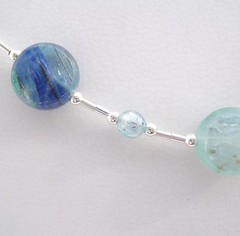
Colour: blue to colourless, blue-green, brown, blue, green, white
Hardness: 6-7 across axis, 4-4.5 along axes
Cleavage: perfect
Fracture: fibrous, brittle
Crystal system: triclinic
Chemical composition: aluminium silicate
Transparency: transparent, translucent
The name Kyanite comes from the Greek word kyanos which means blue. The cut stone often has streaks and is quite difficult to cut due to its cleavage and variable hardness. It is found in Burma, Brazil, Kenya, Austria, Switzerland, India, Australia, Kenya, Zimbabwe and the USA. It can be confused with aquamarine, benitoite, iolite, dumortierite, sapphire and tourmaline.
Metaphysical practioners believe kyanite is useful for meditation, to increase psychic abilities and intuition; to cut through illusion, reduce anger and stress. Crystal healers believe it treats the throat and brain, relieves pain, lowers blood pressure, assists healing after infections, releases excess weight and balances yin-yang energy.
Labradorite
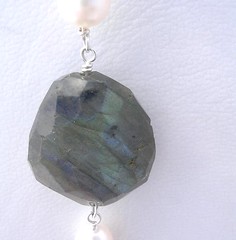
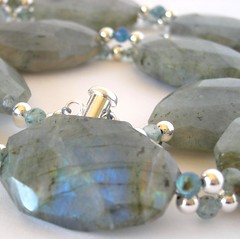
Colour: Dark grey to gray-black with iridescence, colourless, brownish
Hardness: 6-6.5
Cleavage: perfect
Fracture: uneven, brittle, splintery
Crystal system: triclinic
Chemical composition: sodium calcium aluminium silicate
Transparency: transparent to opaque
Labradorite was first found on the Labrador peninsula in Canada, thus its name. A plagioclase feldspar, it shows labradorescence, or a schiller of lustrous metallic tins, usually in blue/green, although all colours are possible. The colourful effects are due to the interference of light at the junctions of the internal structures.
Spectrolite is a trade name for labradorite found in Finalnd that shows the colour play particularly effectively.
There is a lovely origin myth about the northern lights being trapped in the rocks along the Labrador coast and a wandering Eskimo released them back into the sky with a blow from his spear, but some of the lights still remained trapped and this is labradorite. The Inuit claim Labradorite fell from the frozen fire of the Aurora Borealis, its mystical light separating the waking world from unseen realms making it a stone of shamans, diviners and healers.
Found in Canada, Australia, Finland, Norway, Madagascar, Mexico, Russia and the USA. Can be confused with larvikite which is anorthosite containing tiny labradorite crystals.
Metaphysical practioners call Labradorite the ‘wizard’s stone’. They believe it is a mystical and protective stone, forming a barrier to negative energies, taking you into another world or into other lives; that it is both calming and energizing, it imparts strength and perseverance.
Lapis Lazuli

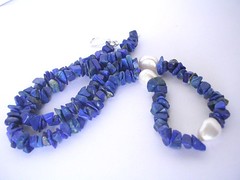
Colour: royal blue, vilet, green-blue
Hardness: 5-6
Cleavage: indistinct
Fracture: conchoidal, grainy
Crystal system: cubic, more often found in a massive form.
Chemical composition: sodium calcium aluminium silicate
Transparency: opaque
Colouring agent: sulphur
Lapis lazuli is actually a rock containing a number of different minerals in differing quantites including lazurite, augite, calcite, diopside, enstatite, mica, hornbelde, hauynite, nosean, sodalite, pyrite. Its name comes from the Latin lapis ‘stone’ and lazuli ‘blue’.Lazuli is an older form of the Arabic word L’azulaus meaning sky, heaven or blue – therefore can be translated as “sky blue stone”. The French word Azur and the English form Azure came from the same roots.
For over 6000 years, the finest lapis lazuli has come from the West Hindu Kush mountains in Afghanistan – where it is found irregularly and in difficult terrain. Lapis from this mine was used in the mask of Tutankhamen. It has been used since prehistoric times in jewellery and during the middle ages was the source of ultramarine for blue paint.
The best quality lapis has good, even blue colour and well distributed pyrite flecks. Some deposits have whitish or gray along with the blue, and some have a high incidence of pyrite which can give a greenish cast. Occasionally, lapis may be heated or dyed to improve colour.
It is found in Afghanistan, Russia, Chile, Argentinia, Angola, Burma, Canada, Pakistan and the USA. It is often confused with sodalite, dumorterite, azurite and dyed howlite.
For centuries it was worn to protect the wearer from evil, to contact guardian spirits and to reverse curses. Metaphysical practioners believe it stimulates enlightment and enhances psychic abilities; releases stress and brings deep peace; brings honesty, and compassion and bonds relationships. Crystal healers have used it to treat depression, the nervous and immune systems and migraines.
Larimar
Colour: blue, blue-green
Hardness: 5
Cleavage: perfect
Fracture: splintery
Crystal System: triclinic, mostly found in massive form.
Chemical composition: acid silicate hydrate of calcium and sodium.
Transparency: opaque
Colouring agent: cobalt
First discovered in 1916 by Father Miguel Domingo Fuertes Loren, larimar is a bright caribbean blue and has only been found in one location in Barahona in the Dominican Republic. Although natives used larimar for their own jewellery, it was not ‘rediscovered’ until 1974 when it was named larimar (after Larisa, daughter of Miguel Mendez, a geologist and mar, the Spanish word for sea) and mining for the stone began in 1975.
Larimar is a form of pectolite which formed in cavities of volcanic rocks. Can be confused with turquoise.
Larvikite
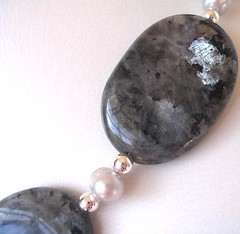
Hardness 6-6.5
Cleavage: perfect in one direction, good in the other.Crystal System: triclinic
Chemical composition: sodium potassium aluminium silicate
Transparency: translucent to opaque Larvikite (laurvikite) was named for the locality – the La(u)rvik Fjord region of Norway – by Waldemar Christofer Brögger, Professor of Petrology at the University of Oslo. It is a coarse grained feldspar rich rock that shows flashes of blue which come from individual grains of labradorite that exhibit a chatoyant-like appearance. Larvikite has a history of being used as a facing stone in architectural applications.Larvikite is sometimes incorrectly sold as labradorite or spectrolite but is more correctly labelled as anorthosite.
Lava

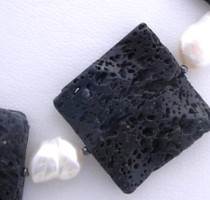
Colour: black, dark brown
Lava rock is an igneous volcanic basalt rock formed during volcanic eruptions. Containing air bubbles called vesicles, these bubbles are formed when gas is trapped and the lava cools and hardens.
Lightweight and smooth, some stones may have had a surface treatment to deepen the colour and reduce abrasiveness. Lava from Mt. Vesuvius (near Pompeii) was popular for jewellery in the 19th century. Currently mined in Iceland, Indonesia.
Metaphysical practioners believe lava is a stone of strength and fertility, that provides stability in times of change, and helps to dissipate anger and provide guidance and understanding as it assists one in “bouncing back”. They consider it a grounding stone and that black Lava strengthens the connection to Mother Earth.
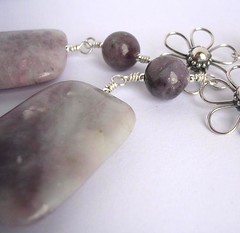
Colour: violet to pale pink, white, gray, yellow.
Hardness: 2.5-3
Cleavage: perfect
Fracture: uneven
Crystal System: monoclinic
Chemical composition: KLi2AlSi4O10F(OH) (potassium lithium hydroxide fluorine aluminium silicate )
The name lepidolite is from the Greek word lepidos, meaning scale and lithos meaning stone.
A form of mica, it contains a lithium and rubellite gives it the pinkish colour and mica platelets give it a somewhat sparkly appearance. It sometimes has black inclusions/markings. Found in Brazil, Russia, Sweden, Argentina, Canada, Madagascar, Zimbabwe and in the USA.
Metaphysical healers believe this gemstone has a calming effect and relieves muscle pain by relaxing the nerves; that it helps people reorganize their old ways of thinking and acting so they can meet the challenge of change.